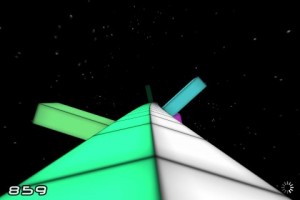 Tunnel Vision
Tunnel Vision
If you were paying close attention to iPod Touch commercials back in 2009 you probably caught a glimpse of Jonathan Lanis’ Boost 3D, featured on Apple’s “best games” list that year. That was before the era of Retina Display, so the developer tunneled right back into the game’s code and overhauled it for the current generation of iDevices. By the time he was done Boost 3D had transformed into Boost 2 (Out Now, $1.99); fans of the original will find the upgrade fairly subtle over all, but this proved a great opportunity to introduce something truly magical to iOS gamers who missed the original.
Boost 2 has the player rushing through a tunnel in first person perspective, tilting the iDevice to shift lanes in hopes of avoiding obstacles. By running over little Boost arrows that appear on occasion, the player gains speed and the ability to bust right through obstacles without perishing. Good thing, too, because a Boost makes it more difficult to avoid crashing in the first place! Boost 2 being an infinite game, the player’s goal is to survive as long as possible – or reach the greatest distance in the shortest time – so he or she can make an impressive showing on OpenFeint and Game Center leaderboards.
 While Boost 2‘s mesmerising presentation will be the first thing to strike players, the strongest impression they’ll leave with is how well-fashioned the Boost formula is at its core. It easily passes my Sonic the Hedgehog 2 minigame test for tunnel gamesTM: despite the breakneck speed at which the player surges forward, he or she has sufficient visual cues to react to whatever’s coming up. The tunnel’s early stages color the lanes on which obstacles are about to appear; the game phases these cues out eventually, but at that point obstacles are grouped into formations the keen eye can pick out from afar. I found it difficult to determine whether Boost 2‘s tunnel is randomly generated or pre-designed, but either way, it has that superb challenging-yet-accessible quality.
While Boost 2‘s mesmerising presentation will be the first thing to strike players, the strongest impression they’ll leave with is how well-fashioned the Boost formula is at its core. It easily passes my Sonic the Hedgehog 2 minigame test for tunnel gamesTM: despite the breakneck speed at which the player surges forward, he or she has sufficient visual cues to react to whatever’s coming up. The tunnel’s early stages color the lanes on which obstacles are about to appear; the game phases these cues out eventually, but at that point obstacles are grouped into formations the keen eye can pick out from afar. I found it difficult to determine whether Boost 2‘s tunnel is randomly generated or pre-designed, but either way, it has that superb challenging-yet-accessible quality.
Boost 2 adds three additional modes of play that twist the original formula. Online Multiplayer lets competitors see who can make it farthest during a sixty second period. A single player Time Trial also puts sixty seconds on a clock, but the player can extend that time by collecting Boosts; crashing subtracts precious seconds from the counter. Finally, an unlockable Survival mode challenges the player to survive as long as possible without the block-breaking benefit of Boosts — while ratcheting up the player’s speed anyway. Boost 2‘s tilt control felt perfectly calibrated to me, but should the player experience any difficulty there’s a calibration setting in its options menu.
 Aesthetically speaking, Boost 2 is incredibly simple and yet pulls off some of the most majestic sights I’ve yet seen on iOS. Long-term survival leads the player through phases of rising difficulty, transitions marked by the tunnel’s own drastic metamorphosis. Watching the environment fold in on itself is an affecting experience that factors into an addictive sense of “being in the zone”. Boost 2 features a single high-octane techno track, but should it wear thin, the game is incredibly welcoming of external music. Jonathan Lanis has gone so far as to create an interface for summoning iTunes tracks without leaving the game — something we should be seeing much, much more of on this platform.
Aesthetically speaking, Boost 2 is incredibly simple and yet pulls off some of the most majestic sights I’ve yet seen on iOS. Long-term survival leads the player through phases of rising difficulty, transitions marked by the tunnel’s own drastic metamorphosis. Watching the environment fold in on itself is an affecting experience that factors into an addictive sense of “being in the zone”. Boost 2 features a single high-octane techno track, but should it wear thin, the game is incredibly welcoming of external music. Jonathan Lanis has gone so far as to create an interface for summoning iTunes tracks without leaving the game — something we should be seeing much, much more of on this platform.
If Boost 2 has a drawback, it is its fundamental nature as an infinite game: aside from the initial “wow” factor its appeal will be short lived if leaderboard competition doesn’t specifically strike the player’s fancy. Nevertheless, its psychedelic presentation and exciting sense of speed will keep players coming back from time to time long after the honeymoon.
iFanzine Verdict: The king of tunnel games has returned and its well-deserved reign continues, thanks to gameplay that’s simple yet challenging, easily approachable yet highly addictive. If you’re into infinite games centered on leaderboards, it doesn’t get any better than this!
[xrr rating=4.5/5]


